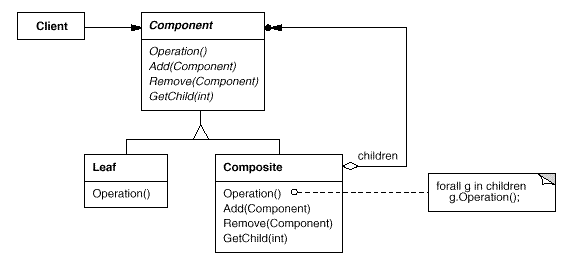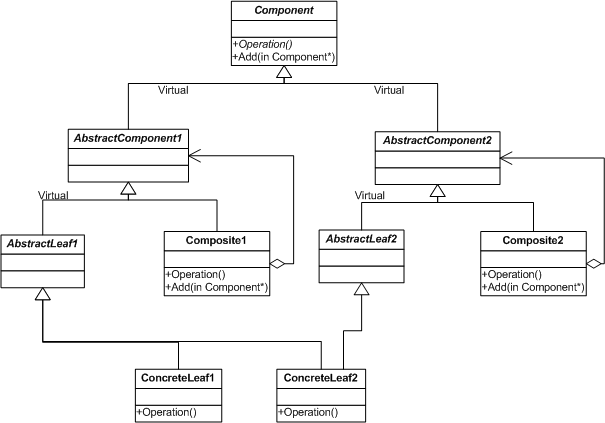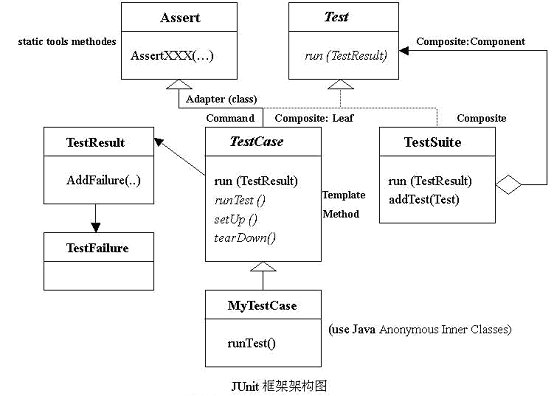一、功能
表示“部分-整体”关系,并使用户以一致的方式使用单个对象和组合对象。
二、结构图

上图中,也可以做些扩展,根据需要可以将Leaf和Composite做为抽象基类,从中派生出子类来。
三、优缺点
优点:对于Composite模式,也许人们一开始的注意力会集中在它是如何实现组合对象的。但Composite最重要之处在于用户并不关心是组合对象还是单个对象,用户将以统一的方式进行处理,所以基类应是从单个对象和组合对象中提出的公共接口。
缺点:Composite最大的问题在于不容易限制组合中的组件。
四、实现
有时需要限制组合中的组件,即希望一个Composite只能有某些特定的Leaf。这个问题我是用多继承和动态类型转换来解决的。假如组合对象Composite1只能包含单个对象ConcreteLeaf1,Composite2可以包含单个对象 ConcreteLeaf1和ConcreteLeaf2。如下图所示:

上图中的类层次比较多,使用了AbstractLeaf1和AbstractLeaf2,但没使用 AbstractComposite1和AbstractComposite2,这个并不重要,也可以把AbstractLeaf1和 AbstractLeaf2去掉,这个并不重要,可以根据具体情况决定要不要。
简单的代码实现如下:
namespace DesignPattern_Composite
{
class Component
{
public:
virtual void operation() = 0 ;
virtual void Add(Component*) {}
} ;
class AbstractComponent1 : virtual public Component {} ;
class AbstractLeaf1 : virtual public AbstractComponent1 {} ;
class Composite1 : public AbstractComponent1
{
public:
virtual void operation() { /* do operation */ }
virtual void Add(Component*) ;
} ;
void Composite1::Add(Component *p)
{
AbstractComponent1 *pc1 = dynamic_cast<ABSTRACTCOMPONENT1*>(p) ;
if (pc1 == NULL) return ;
// do add operation
}
class AbstractComponent2 : virtual public Component {} ;
class AbstractLeaf2 : virtual public AbstractComponent2 {} ;
class Composite2 : public AbstractComponent2
{
public:
virtual void operation() { /* do operation */ }
virtual void Add(Component*) ;
} ;
void Composite2::Add(Component *p)
{
AbstractComponent2 *pc2 = dynamic_cast<ABSTRACTCOMPONENT2*>(p) ;
if (pc2 == NULL) return ;
// do add operation
}
class ConcreteLeaf1 : public AbstractLeaf1
{
public:
virtual void operation() { /* do operation */ }
} ;
class ConcreteLeaf2 : public AbstractLeaf1, public AbstractLeaf2
{
public:
virtual void operation() { /* do operation */ }
} ;
}
客户端代码:
{
using namespace DesignPattern_Composite ;
Component *pc1 = new ConcreteLeaf1() ;
Component *pc2 = new ConcreteLeaf2() ;
Component *pc3 = new Composite1() ;
Component *pc4 = new Composite2() ;
pc3->Add(pc1) ; // ok
pc3->Add(pc2) ; // ok
pc3->Add(pc3) ; // ok
pc3->Add(pc4) ; // fail
pc4->Add(pc1) ; // fail
pc4->Add(pc2) ; // ok
pc4->Add(pc3) ; // fail
pc4->Add(pc4) ; // ok
}
有两点需要注意,一是因为用了多继承,所以需要使用virtual inheritance。二是要用dynamic_cast来判断是否允许组合该组件。
五、示例代码
namespace DesignPattern_Composite
{
// class Component
class Component
{
public:
virtual void Operation() = 0 ;
virtual void Add(Component*) {}
} ;
// class Leaf
class Leaf : public Component
{
public:
virtual void Operation() {}
} ;
// class Composite
class Composite : public Component
{
public:
virtual void Add(Component *p) { _list.push_back(p) ; }
virtual void Operation()
{
vector< Component* >::const_iterator it ;
for (it = _list.begin(); it != _list.end(); it++)
(*it)->Operation() ;
}
private:
vector< Component* > _list ;
} ;
}
六、实例
(1)JUnit中就用的是Composite模式。
